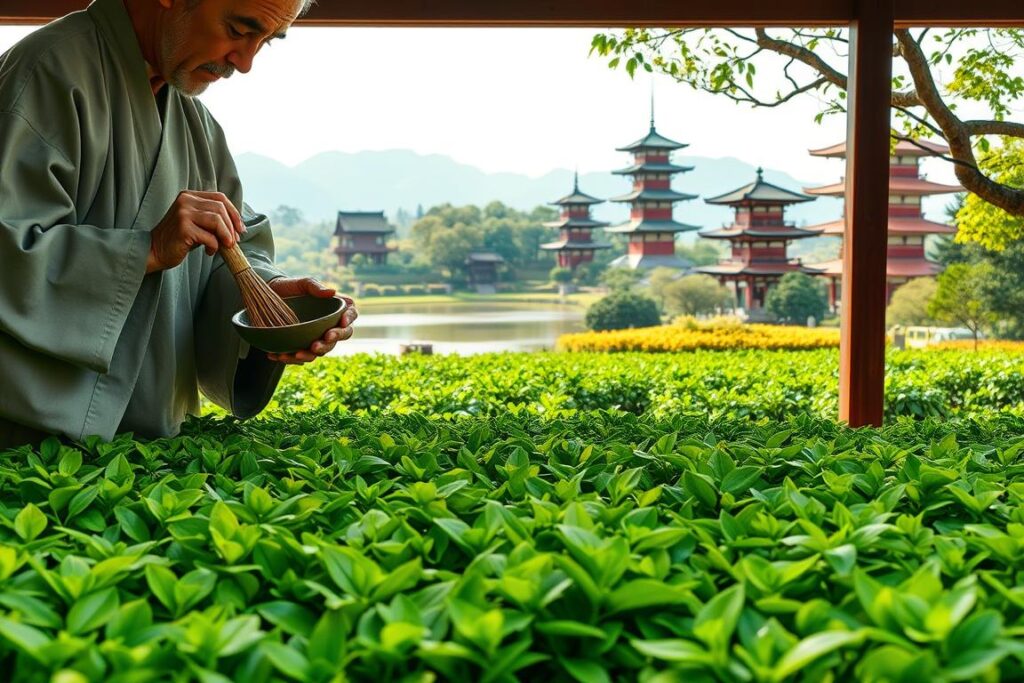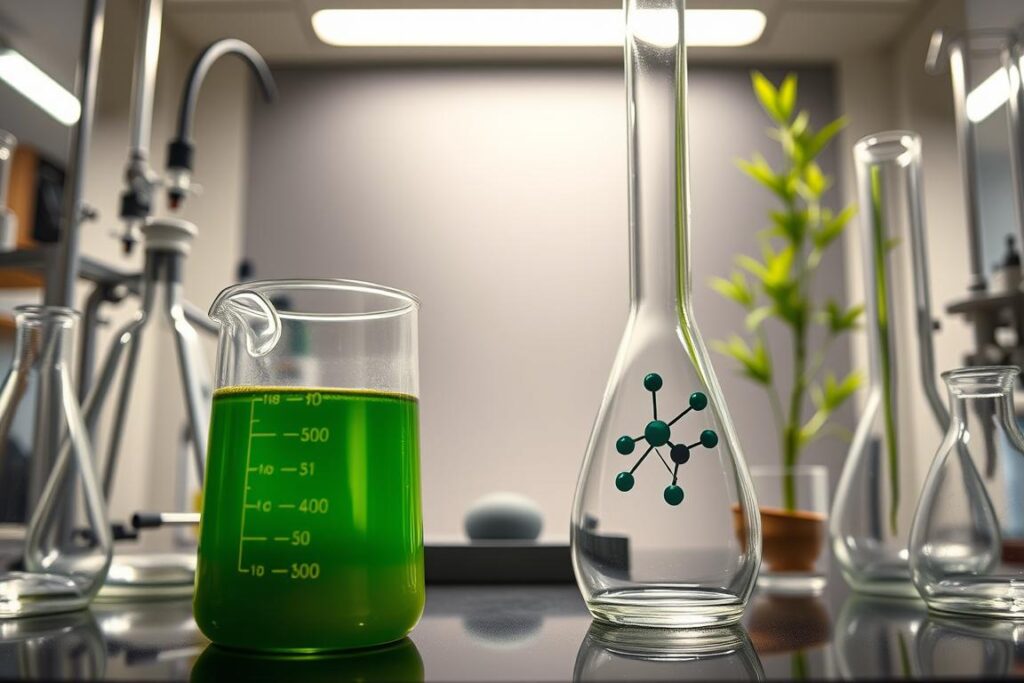That first sip of green tea powder awakened something in me. It was a vibrant energy unlike any coffee I’d experienced before. Matcha wasn’t just a beverage; it was a revelation of sustained, calm alertness that transformed my mornings.
When you’re curious about caffeine in your antioxidant treats, matcha delivers a unique punch. Unlike traditional coffee, this green tea powder offers a nuanced energy experience. Typically, matcha contains approximately 20-45 mg of caffeine per gram. This means a standard serving of 2-4 grams can provide 40-180 mg of caffeine per cup.
Crafting matcha brownies or exploring this vibrant green tea powder opens a world of energizing possibilities. Your body absorbs matcha’s caffeine differently. This creates a smoother, more sustained release compared to other caffeinated beverages.
Key Takeaways
- Matcha contains 20-45 mg of caffeine per gram
- A typical serving provides 40-180 mg of caffeine
- Green tea powder offers a unique energy experience
- Matcha can be used in various antioxidant treats
- Caffeine absorption differs from traditional coffee
Understanding Matcha: Origins and Production
Matcha is a beloved Japanese treat with a long history. It’s a vibrant green powder that has become popular in baking. It’s loved by food lovers all over the world.

Traditional Japanese Processing Methods
Matcha’s journey starts with careful cultivation and processing. Farmers in places like Uji, Fukuoka, and Kagoshima use old methods:
- They pick the youngest, most tender tea leaves
- They steam leaves to stop oxidation
- They dry and sort leaves with great care
- They grind leaves into a fine powder
The Importance of Shade Growing
Shade growing is key in making matcha. Tea plants are covered for weeks before harvest. This changes the leaves in amazing ways:
- It makes leaves green and rich in chlorophyll
- It increases amino acids
- It makes the leaves more nutritious
Different Grades of Matcha
Matcha has different qualities for various uses:
- Ceremonial Grade: The best, for tea ceremonies
- Premium Grade: Great for drinking
- Culinary Grade: Best for baking and treats
Learning about matcha’s production shows its value. It’s not just a trend—it’s a sign of Japanese skill in farming.
The Science Behind Matcha’s Caffeine Content

Matcha’s caffeine profile is unique, making it a favorite for those who want energy that lasts. Unlike coffee, matcha offers a balanced way to get caffeine.
Matcha has about 70 mg of caffeine per gram of powder. This is different from other drinks. Its special chemical makeup is key:
- Slow-release caffeine mechanism
- Presence of L-theanine amino acid
- Reduced caffeine crash
The L-theanine in matcha is important. It helps caffeine work better. This amino acid makes you feel calm yet alert, unlike coffee.
When you make vegan brownies with matcha, you add more than flavor. You also get a smart energy boost.
“Matcha transforms caffeine consumption from a sudden jolt to a smooth, sustained energy experience.”
Studies show matcha can boost energy by 4-5% over 24 hours. It’s a great choice for natural energy.
Experts say to use 1-2 teaspoons of matcha for the best effect. This gives you 140-280 mg of balanced caffeine.
Comparing Caffeine Levels: Matcha vs Coffee
Looking for snacks that give you energy without guilt? It’s key to know how matcha and coffee stack up. These drinks have unique energy profiles that affect your day and health.
Learn more about how much caffeine is in matcha and how it compares to other caffeinated beverages.
Average Caffeine Content Per Serving
Here’s a look at the caffeine in these drinks:
- Matcha: About 70 mg of caffeine per 8 oz serving
- Coffee: Roughly 95 mg of caffeine per 8 oz serving
Duration of Energy Effects
How these drinks give you energy is fascinating. Coffee gives a quick boost, but matcha offers a steady, balanced energy. Matcha’s special mix lets caffeine release slowly, avoiding coffee’s crash.
Impact on Body and Mind
Matcha is great for those making fudgy desserts or looking for healthier snacks. It has L-theanine, which helps with:
- Calm, focused energy
- Less anxiety
- Better mental clarity
Coffee, on the other hand, can make you feel stressed and quickly lose energy. Choosing matcha treats means smoother, more controlled energy.
L-Theanine: Matcha’s Secret Energy Weapon
Matcha gives you a special kind of energy that’s different from regular caffeine drinks. It’s thanks to an amino acid called L-theanine. This amino acid changes how your body uses energy.
When you enjoy matcha in gluten-free sweets or superfood baking, you get more than just a tasty treat. You unlock a powerful brain booster.
L-theanine creates a calm alertness state. It’s unlike coffee’s jittery feeling. You’ll feel focused and relaxed at the same time. This makes matcha perfect for balanced mental performance.
- Reduces stress without sedation
- Enhances mental clarity
- Promotes relaxed concentration
- Supports stable energy levels
In superfood baking, matcha adds flavor and benefits. Whether it’s gluten-free sweets or energy-boosting treats, L-theanine gives you a gentle energy boost. Your recipes become more than just tasty – they’re wellness tools.
L-theanine transforms matcha from a simple beverage into a holistic wellness experience.
Nutrition experts see L-theanine’s value for brain health. It helps regulate neurotransmitters, keeping you calm and focused, even when stressed. Your matcha-infused creations can now be delicious ways to support mental well-being.
How Matcha Affects Your Body Differently Than Coffee
Green tea powder, or matcha, is a unique alternative to morning coffee. It offers a healthier way to boost energy and focus.
Choosing matcha means you get a balanced energy boost. Unlike coffee, which gives a quick caffeine rush, matcha’s energy release is slower and more controlled.
One of the best ways to enjoy matcha’s benefits is by incorporating it into baked goods. From fudgy matcha brownies to energy-packed cookies, this vibrant green powder adds flavor and health benefits.
Absorption Rate and Energy Release
Matcha’s caffeine works differently in your body than coffee’s. The main differences are:
- It absorbs slower because of special catechin molecules
- Energy is released gradually, avoiding sudden drops
- It keeps your mind alert and focused steadily
Impact on Blood Sugar Levels
Matcha affects your body in a unique way. It helps keep blood sugar levels stable, unlike coffee which can cause big energy swings.
| Beverage | Caffeine Content | Energy Stability | Mental Focus |
|---|---|---|---|
| Matcha | 70 mg per serving | High | Sustained |
| Coffee | 95 mg per serving | Low | Intermittent |
Effects on Mental Clarity
Matcha combines caffeine and L-theanine for calm alertness. It improves focus without the jitters coffee can cause. It’s perfect for a balanced energy boost every day.
Recommended Daily Matcha Intake
Knowing how much matcha to drink each day is key to enjoying its health perks. Experts say to stick to 1-2 servings a day. Each serving should have about 1-2 grams of matcha powder.
Here are some tips for using matcha right:
- Aim for 70 mg of caffeine per serving
- Spread out your antioxidant treats all day
- Pay attention to how your body reacts to matcha
Your body might react differently to matcha, so start small. If you’re sensitive to caffeine, be extra careful. Matcha’s mix of L-theanine and caffeine gives you energy without the jitters.
“Moderation is key when enjoying the rich benefits of matcha” – Japanese Tea Experts
If you’re making treats with matcha, use the right amount. A serving is usually 1/2 to 1 teaspoon of good-quality matcha powder.
Don’t forget, matcha stays fresh longer if stored right. Keep it in a sealed container, away from light and heat. This keeps its nutrients strong and you get the best from these antioxidant treats.
Delicious Matcha Brownies and Other Energy-Boosting Treats
Turn your favorite brownies into a boost of energy with matcha. These treats mix the rich taste of brownies with matcha’s unique flavor and energy.
To make the best matcha brownies, focus on a few important steps:
- Choose high-quality ceremonial grade matcha for the best taste
- Use 1-2 teaspoons of matcha powder per batch of brownies
- Try gluten-free options like almond flour for more nutrition
Matcha brownies offer about 35-70 mg of caffeine per serving. This is a more balanced energy boost than coffee. The fudgy desserts get a special kick from matcha, making them a healthier snack option.
Here are some creative ways to make your matcha brownies even better:
- Add almond pieces for extra protein
- Include lemon zest for a vitamin C boost
- Drizzle white chocolate ganache for a sweet treat
Pro tip: Mix the matcha powder well to spread the flavor and energy evenly. This way, your matcha brownies will not only taste great but also give you a gentle energy boost.
The Role of Quality in Matcha’s Caffeine Content
Exploring superfood baking shows how matcha quality affects its caffeine and taste. Not all matcha is the same, which changes how your vegan brownies and other dishes turn out.
Knowing about matcha quality can make your baking better. Matcha has 19-44 mg of caffeine per gram. This amount can vary based on several important factors.
Ceremonial Grade vs Culinary Grade Matcha
There are two main types of matcha:
- Ceremonial Grade Matcha:
- Top quality
- Smoothest texture
- Deepest flavor
- Most caffeine
- Culinary Grade Matcha:
- More budget-friendly
- Slightly bitter taste
- Great for baking and cooking
- Less caffeine
Storage and Freshness Factors
Keeping matcha fresh is key to its caffeine and taste. Store it in an airtight container in the freezer. This stops it from getting old and losing its good stuff. Freshly ground matcha is the best for baking.
Choose high-quality matcha for your vegan brownies. Look for vibrant green color and a rich taste. Your treats will be even better because of it!
Health Benefits Beyond Caffeine
Matcha is more than just a caffeine boost. It’s full of antioxidants, like catechins, making it a health powerhouse. It’s packed with nutrients that help your body fight off diseases and improve your health in many ways.
Adding matcha to gluten-free sweets and snacks does more than just satisfy your taste buds. Its antioxidants may help your heart and even fight cancer. Brands like Hugo Tea focus on quality to ensure you get the most health benefits.
Matcha is great in many ways, from smoothie bowls to energy bites. It can boost your metabolism and improve your focus. It’s a natural, healthy choice for those looking for better energy sources.
Choosing matcha means you’re picking a drink or ingredient that supports your health. It’s perfect for making snacks that are both tasty and healthy. Matcha is a delicious way to boost your energy and health.
